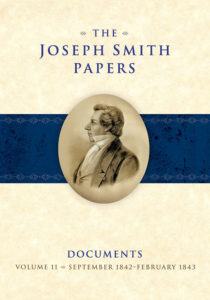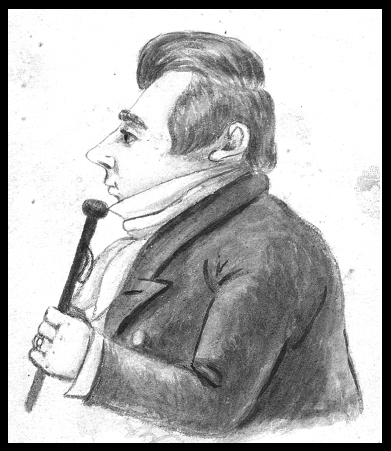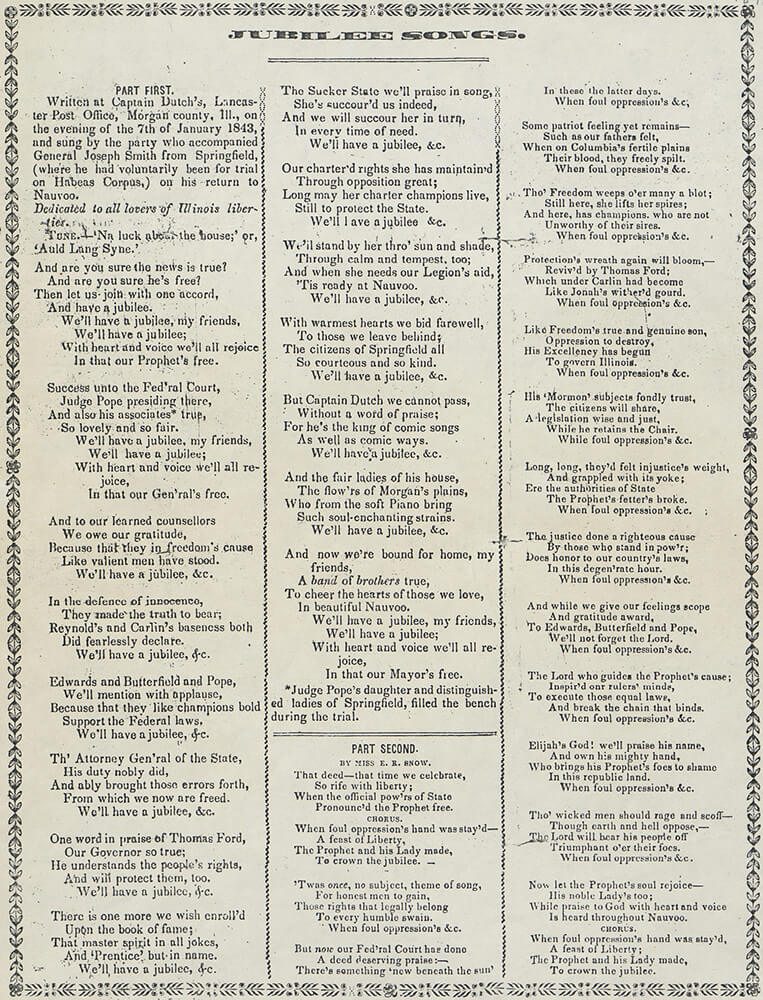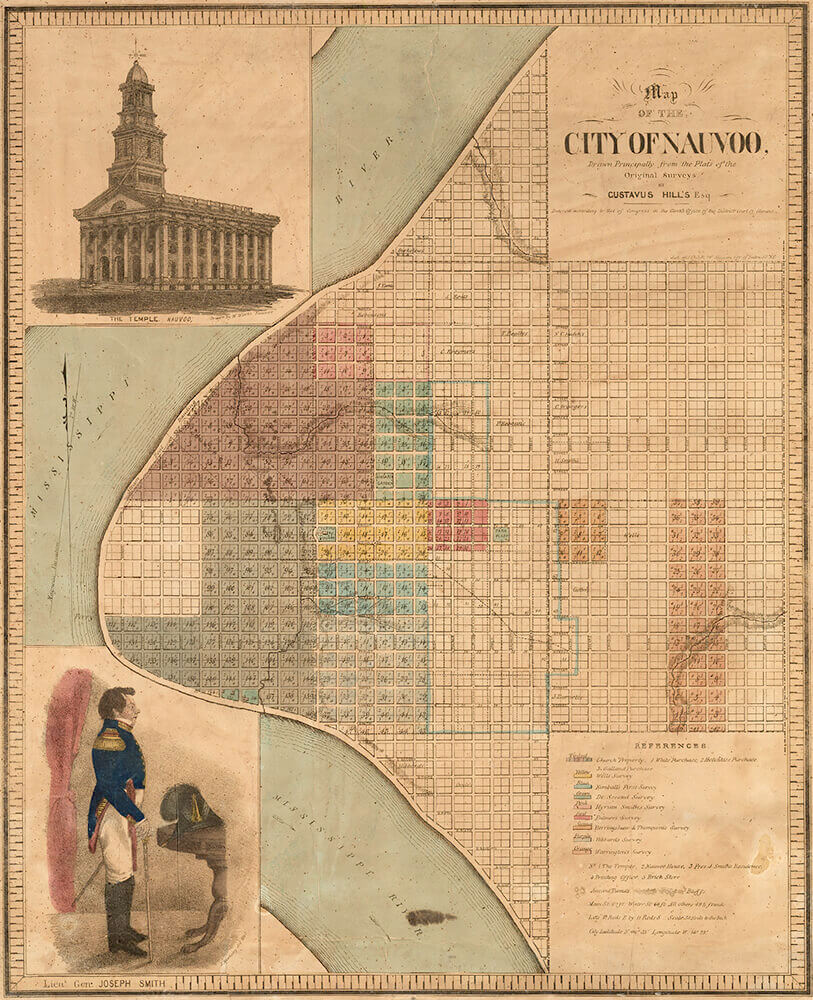
This volume of the Documents series of the Joseph Smith Papers covers a period of time when Joseph Smith hid from attempts to arrest and extradite him to Missouri while trying to lead Nauvoo and the Church. He then had a legal victory which enabled him to come out of hiding and attend to many items of business, including continuing to teach the Saints and becoming mayor of Nauvoo. The collection of 105 documents includes letters, poems, discourses, deeds, notices, meeting minutes, affidavits, songs, etc. These combine to paint an interesting picture of a very busy time in Joseph’s life.
Among the illustrations in the introduction is a sketch of Joseph Smith by local artist Benjamin West, done during an extradition hearing in Springfield, Illinois, in January 1843. It is unknown whether it was meant to be accurate or more of a caricature, but it does match written descriptions of Joseph (see https://www.churchofjesuschrist.org/study/new-era/2005/12/what-did-joseph-smith-really-look-like?lang=eng).

One interesting document included is a summary of a discourse given on October 29, 1842:
President Joseph spoke to them considerable, showing them the proper course to pursue and how to act in regard to making purchases of land &c. He showed them that it was generally in consequence of the brethren disobeying or disregarding council, that they became dissatisfied and murmered; and many when they arrived here were dissatisfied with the conduct of some of the saints because every thing was not done perfectly right, and they get mad and thus the devil gets advantage over them to destroy them. He said he was but a man and they must not expect him to be perfect; if they expected perfection from him, he should expect it from them, but if they would bear with his infirmities and the infirmities of the brethren, he would likewise bear with their infirmities. He said, it was likely he would have again to hide up in the woods, but they must not be discouraged but roll on the city, the Temple &c. When his enemies took away his rights he would bear it and keep out of the way but “if they take away your rights I will fight for you.” (page 190)
The advice that “if they would bear with his infirmities and the infirmities of the brethren, he would likewise bear with their infirmities” still seems good today.
A letter dated as “Journeying Sept. 6th, 1842” is probably misdated and was actually written on September 7. “JS was in hiding at this time. ‘Journeying’ was likely written to conceal his whereabouts from those seeking his arrest and extradition.” (page 59, footnote 361) This letter gives detailed instructions on recording baptisms for the dead and also gives a sermon on the topic. It became Doctrine and Covenants Section 128.
A fun document in the book is a broadside of “Jubilee Songs” that were written to commemorate Joseph Smith’s legal victory ending the threat of extradition. One of them was written by Wilson Law and Willard Richards and sung by the party with Joseph Smith on the way from Springfield back to Nauvoo. Another was written by Eliza R. Snow. The broadside was commissioned to be printed for a party celebrating Joseph’s release and then later sold to the public.

Another item that I enjoyed is “Poem to William W. Phelps,” which is a response to an earlier poem (also in the volume) by Phelps to Joseph Smith. It is thought that since Joseph had very little experience writing poetry, Phelps may have helped him with it. The poem is based on “The Vision,” which was received by Joseph Smith and Sidney Rigdon, contained in Doctrine and Covenants 76. It contains some things that are not in D&C 76, such as the mention of Kolob and the council in heaven, that would have come from the Book of Abraham. The picture below is of the first page. The poem goes on for 78 verses.
A copyright for a map of Nauvoo was filed by Willard Richards on December 17, 1842. It includes a portrait of Joseph Smith by Sutcliffe Maudsley. “The level of detail and variety of colors in the map rivaled or exceeded those of published maps of other large western cities of the time” (page 289). The map was not completed until April, 1844. (The version in the book is not in color.)

This volume gives us a glimpse of a busy period in Nauvoo and of the prophet Joseph Smith’s life during the six months it covers. An interested reader could easily spend hours engrossed in its various documents, and it should prove invaluable to scholars. As with the other volumes in the series, the detailed footnotes, introductions, and other material alongside the documents make the printed book very much worth having.
Additional resources from the volume editors:
Worship Services in the Unfinished Nauvoo Temple
Historian Spencer W. McBride explains how Latter-day Saints in Nauvoo used the still-unfinished Nauvoo temple for worship services in 1842 and 1843.
Recording Baptisms for the Dead in Nauvoo
Historian Brett D. Dowdle displays the rarely seen record of baptisms for the dead in the Nauvoo temple and explains its significance to Latter-day Saints.


